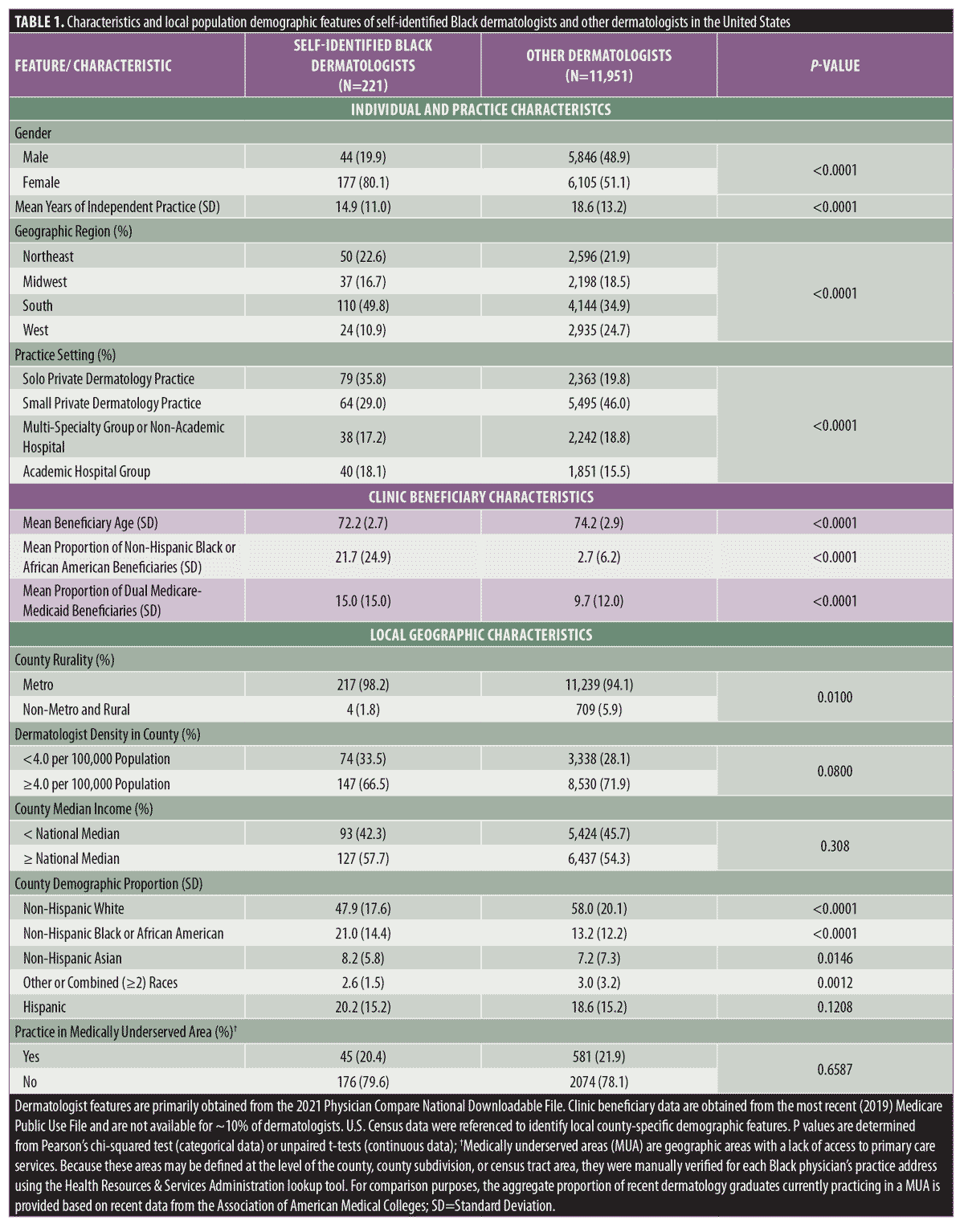 J Clin Aesthet Dermatol. 2023;16(3):27–29.
J Clin Aesthet Dermatol. 2023;16(3):27–29.
by Vijay Kodumudi, MD; Christian Gronbeck, MD; and Hao Feng, MD, MHS
Dr. Kodumudi is with the University of Connecticut School of Medicine in Farmington, Connecticut. Drs. Gronbeck and Feng are with the Department of Dermatology at the University of Connecticut Health Center in Farmington, Connecticut.
FUNDING: No funding was provided for this article
DISCLOSURES: Dr. Feng is a consultant with Cytrellis Biosystems Inc. and Soliton Inc.
ABSTRACT: There is a documented shortage of Black dermatologists in the United States, with little known about their practice characteristics. We analyzed the practice patterns (e.g., location, group setting, beneficiary characteristics, local geographic characteristics) of 221 self-identified Black dermatologists in the Black Dermatologist Directory through analysis of publicly available Medicare datasets. Compared to non-Black dermatologists, Black dermatologists were more likely to be female (80.1% vs. 51.1%), practice in the South (49.8% vs. 34.9%), work in solo practices (35.8% vs. 19.8%) or academic centers (18.1% vs. 15.5%), and practice in counties with a higher proportion of non-Hispanic Black individuals (21.0% vs. 13.2%). Black dermatologists treated a higher proportion of non-Hispanic Black Medicare beneficiaries (21.7% vs. 2.7%) and dual Medicare-Medicaid beneficiaries (15.0% vs. 9.7%). Major limitations include reliance on public data which may incompletely capture all practicing Black dermatologists. Overall, the findings support the important role of Black dermatologists in treating minority and Medicaid beneficiaries; increased representation of Black dermatologists may ultimately allow for improved patient access and promote awareness and knowledge of specific dermatologic needs of Black patients among the broader dermatology community.
Keywords: Black dermatologists, dermatologic access, minority physicians, medicare beneficiaries, practice setting
There is a well-documented shortage of Black physicians in medicine and specifically dermatology. Currently, only three percent of dermatologists identify as Black, far less than the population proportion of Black individuals (13%).1 Physician-patient race concordance may help to improve patient satisfaction and engagement.6 Given that little is known about the practice characteristics of Black dermatologists in the United States, we conducted an analysis of self-identified Black dermatologists to elucidate their geographic locations and the patient populations they treat.
METHODS
We performed a cross-sectional review of Black dermatologists in the Black Dermatologist Directory, an online resource that lists self-identified Black dermatologists in the United States and seeks to address the unique dermatologic issues of Black patients.1 Individual practice characteristics of Black dermatologists listed in the directory were determined by using the Physician Compare National File, and these practice characteristics were compared to those of all other dermatologists in the dataset.2 For a minority of recent Black dermatology graduates, we supplemented our review with targeted searches of physician websites. We further resourced the Medicare Public Use File to obtain clinic beneficiary data and census data to obtain county sociodemographic information.3
RESULTS
We analyzed a total of 221 self-identified Black dermatologists, comprising 1.8 percent of all dermatologists in the National File. Compared to other dermatologists, Black dermatologists were more likely to be female (80.1% vs. 51.1%, p<0.0001), practice in the South (49.8% vs. 34.9%, p<0.0001), and work in solo practices (35.8% vs. 19.8%, p<0.0001) or academic centers (18.1% vs. 15.5%, p<0.0001). They were more likely to practice in counties with a higher proportion of non-Hispanic Black population (21.0% vs. 13.2%, p<0.0001) and non-Hispanic Black beneficiaries accounted for a higher proportion of their Medicare patients (21.7% vs. 2.7%, p<0.0001). Black dermatologists practiced in medically underserved areas to a similar degree as other dermatologists (20.4% vs. 21.9%, p=0.6587) (Table 1).4

DISCUSSION
The explanation for the greater proportion of Black dermatologists in solo practice is unclear. It is possible that solo settings allow greater autonomy for these physicians to address the unique dermatologic issues of their patient populations. The notable role of Black dermatologists in academic institutions is encouraging, and their role in teaching, mentoring, and leadership may help to increase underrepresented minority trainees in dermatology.
The data indicate that Black dermatologists care for a significant proportion of non-Hispanic Black and dual Medicaid-Medicare beneficiaries. Multiple factors may be contributing to this, including location of Black dermatologists in counties with a high proportion of Black individuals and possible personal aims to care for underserved patients. Additionally, Black patients may actively seek care from Black dermatologists. Adherence to dermatologic therapy may be 11 percent higher among race concordant patient-provider dyads,5 reinforcing the importance of supporting recruitment of Black dermatologists to promote patient access and engagement. Interestingly, Black dermatologists were not more likely to practice in medically underserved areas, which are often rural and lack access to primary care. This underscores the need for simultaneous efforts to recruit dermatologists from rural or underserved backgrounds and those with specific interests to practice in medically underserved areas.
This study relies primarily on public data and may incompletely capture of all practicing Black dermatologists. Some of the dermatologists in the comparison group may identify as Black yet not appear in the Black Dermatologist Directory. Still, this study helps to better discern the current practice characteristics of Black dermatologists. Increased representation of Black dermatologists may ultimately allow for improved patient access and promote awareness and knowledge of specific dermatologic needs of Black patients among the broader dermatology community.
References
- Black Dermatologist Directory. Directory. https://www.blackdermdirectory.com/directory. Accessed July, 4 2022.
- Centers for Medicare and Medicaid Services. National Downloadable File. https://data.cms.gov/provider-data/dataset/mj5m-pzi6. Accessed July 6, 2022.
- Centers for Medicare and Medicaid Services. Medicare Physician & Other Practitioners – by Provider. https://data.cms.gov/provider-summary-by-type-of-service/medicare-physician-other-practitioners/medicare-physician-other-practitioners-by-provider. Accessed June 28, 2022.
- Association of American Medical Colleges. Table C2. Number of Individuals Who Completed Residency and Are Practicing in Federally Designated Medically Underserved Areas, by Last Completed GME Specialty. https://www.aamc.org/data-reports/students-residents/interactive-data/report-residents/2021/table-c2-number-individuals-who-completed-residency-and-are-practicing. July 2, 2022.
- Adamson AS, Glass DA, Suarez EA. Patient-provider race and sex concordance and the risk for medication primary nonadherence. J Am Acad Dermatol. Jun 2017;76(6):1193–1195.

